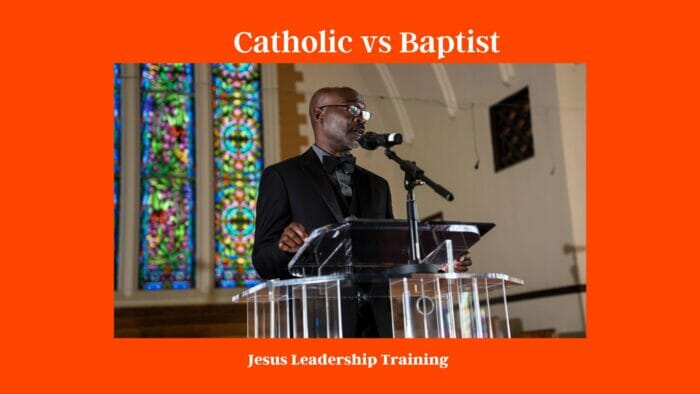Catholic vs Baptist – In this comprehensive guide, we explore the similarities and differences between Catholic and Baptist beliefs, their history, and the impact of these differences on interfaith relationships and understanding.
Table of Contents
Catholic vs Baptist
Catholicism and Baptism are two significant denominations within the Christian faith, each with distinct beliefs and practices. The Catholic Church, the largest Christian body globally, traces its origins to Jesus Christ and places significant emphasis on tradition, the Seven Sacraments, and the authority of the Pope.
On the other hand, Baptists emerged from the Protestant Reformation, advocating for believer’s baptism, congregational governance, and the Bible as the ultimate authority in faith and practice. While both denominations share a fundamental belief in Jesus Christ as Savior, their theological, liturgical, and governance differences make for a diverse expression of Christian faith.
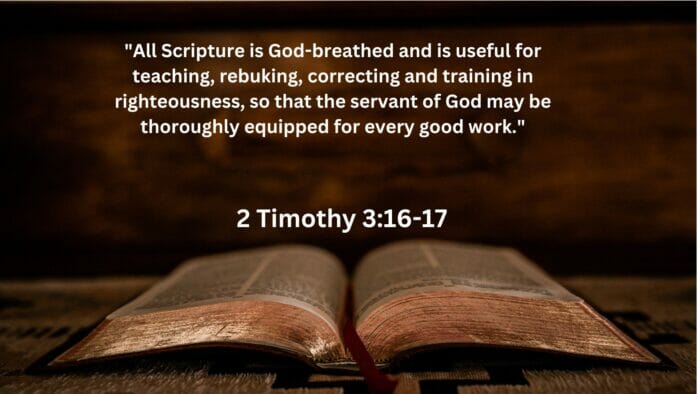
here’s a table summarizing some of the major beliefs and practices of the Catholic and Baptist traditions:
| Belief/Practice | Catholicism | Baptist |
|---|---|---|
| God | Believes in the Trinity – God as Father, Son, and Holy Spirit. | Believes in the Trinity – God as Father, Son, and Holy Spirit. |
| Jesus Christ | Jesus is the Son of God, Savior of humanity, true God and true man. | Jesus is the Son of God, Savior of humanity, true God and true man. |
| The Bible | The Bible, along with the tradition and teachings of the Church, forms the foundation of faith and morals. | The Bible alone (sola scriptura) is the ultimate authority in matters of faith and practice, often interpreted literally. |
| Salvation | Salvation is through faith and good works, as well as through the sacraments. | Salvation is through faith alone (sola fide), an individual’s personal relationship with Jesus Christ. |
| Sacraments | Recognizes seven sacraments: Baptism, Eucharist, Reconciliation, Confirmation, Marriage, Holy Orders, and Anointing of the Sick. | Recognizes two ordinances: Baptism and the Lord’s Supper (Communion). |
| The Pope | The Pope is the Bishop of Rome and the leader of the worldwide Catholic Church. | Does not recognize the Pope, supports local church autonomy and the ‘priesthood of all believers’. |
| Mary and the Saints | Highly venerates Mary as the Mother of God, and saints as holy individuals who can intercede on behalf of people. Prayers can be directed to Mary and the saints. | Respects Mary as the mother of Jesus, but does not venerate her or the saints, nor does it practice praying to them. |
| Afterlife | Believes in Heaven, Hell, and Purgatory (a state of purification before entering Heaven). | Believes in Heaven and Hell, but generally does not accept the concept of Purgatory. |
| Worship Style | Worship is structured and liturgical, centered around the Mass and Eucharist. | Worship is often less formal, emphasizes preaching, Bible study, and individual’s personal relationship with God. |
The Meaning of Catholic
Roman Catholic
The term “Catholic” is usually associated with the Roman Catholic Church, the largest Christian body globally, led by the Pope in Vatican City. The Church traces its origins directly to Jesus Christ, who, according to their belief, appointed the Apostle Peter as the first Pope. Today, the Roman Catholic Church boasts over a billion members worldwide, making it a significant influence in global Christianity.
Etymology
The term “Catholic” originates from the Greek word ‘Katholikos,’ which translates to “universal.” It first appeared in the writings of Ignatius of Antioch around 110 A.D, where he emphasized the unity and universality of the Church. The Church itself holds the doctrine of Catholicity, asserting its universal authority and inclusiveness.
The name ‘Catholic’ is a term used to describe the Christian Church and its followers. Its origin dates back to the days of the early Church, and its exact etymology has been the subject of debate among scholars for centuries. In this blog, we will explore the various origins of the name ‘Catholic’ and the various languages that have been used to describe it.
Origin
The word ‘catholic’ comes from the Latin term ‘catholicus’, which means ‘universal’ or ‘all-embracing’. This term was used to describe the Church’s belief that it is the one true church, and that it embraces all people regardless of race, class, or gender. This concept of universalism was central to the Church’s teaching from the very beginning.
Hebrew
The Hebrew equivalent of ‘catholic’ is ‘kol’, which means ‘all’ or ‘everything’. This word was used to describe the Church’s belief in the universal nature of Christ’s teachings. It was also used to describe the Church’s belief that all people are equal in the eyes of God.
Greek
The Greek term for ‘catholic’ is ‘pas’, which translates to ‘all’ or ‘whole’. It was used to describe the Church’s belief that all people are included in the grace of God and that all people have a place in the Kingdom of Heaven.
Aramaic
The Aramaic term for ‘catholic’ is ‘katholikos’, which translates to ‘general’ or ‘global’. This term was used to describe the Church’s belief that the teachings of Jesus were meant for all people, regardless of language, culture, or background.
Latin
The Latin term ‘catholicus’ was used to describe the Church’s belief that its teachings were universal and applicable to all people. This term was also used to describe the Church’s belief that its teachings were infallible and that it was the one true Church.
Catholic Schools
Catholic schools represent an integral aspect of the Catholic Church. They’re established to provide a learning environment infused with Catholic values, teaching students about the faith while also imparting a standard academic curriculum. Education in Catholic schools is often centered around instilling a sense of community and service to others.
here’s a table summarizing some of the perceived pros and cons of attending Catholic schools:
| Pros | Cons |
|---|---|
| Values and Discipline: Catholic schools often promote strong values and discipline, encouraging personal and spiritual growth alongside academic learning. | Limited Religious Diversity: As religious institutions, Catholic schools often focus on Catholic teachings, which may limit exposure to other religious perspectives. |
| Academic Excellence: Many Catholic schools are known for their rigorous academic programs and high college acceptance rates. | Tuition Costs: Unlike public schools, Catholic schools typically require tuition, which may present financial challenges for some families. |
| Community: The smaller size of many Catholic schools can foster a sense of community, where students often know their peers and teachers well. | Lesser Extracurricular Diversity: Some Catholic schools may not have the resources to provide as many extracurricular and elective options as larger public schools. |
| Sacramental Preparation: Catholic schools provide education in the faith, including preparation for sacraments like First Communion and Confirmation. | Adherence to Catholic Teachings: Students and families may struggle if their personal beliefs conflict with Catholic teachings, particularly on social issues. |
| Safe and Respectful Environment: Catholic schools often emphasize respect for all individuals, and many parents perceive them as providing a safe environment. | Limited Enrollment: In some areas, demand for Catholic education can exceed the number of available seats, making admission competitive. |
The Meaning of Baptist
Beliefs
Baptists are a group of Christians known for their emphasis on believer’s baptism (as opposed to infant baptism), congregational governance, and religious liberty. The Baptist faith strongly advocates the priesthood of all believers, which affirms every Christian’s right and responsibility to directly access God without the need for a priestly mediator.
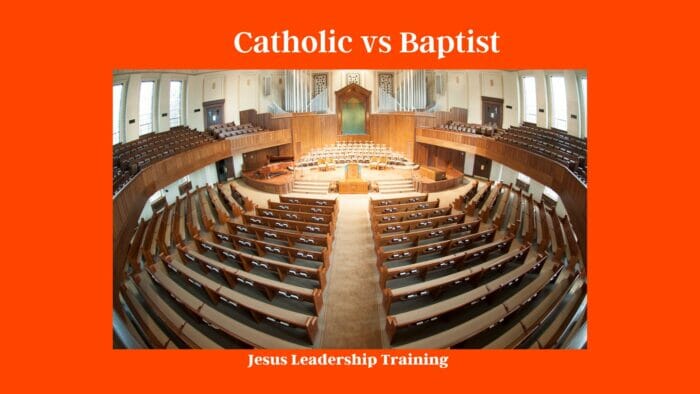
Minister
In Baptist churches, ministers, often called pastors, play a vital role. Their responsibilities typically include preaching, teaching, and administering sacraments. However, the ultimate authority in a Baptist church is the congregation itself, each member having equal say in church matters, reflecting their democratic ideals.
Baptist Denominations
Baptists are not a monolithic group; they have various denominations, each holding unique beliefs and practices. Some of the prominent denominations include Southern Baptist, American Baptist, Independent Baptist, and many more. These groups differ on issues such as Calvinistic vs. Arminian theology, charismatic practices, and the role of women in ministry.
here’s a table summarizing three of the major Baptist denominations and their key differences:
| Denomination | Beliefs and Practices | Distinctive Characteristics |
|---|---|---|
| Southern Baptist Convention (SBC) | Adheres strictly to the belief in the inerrancy of the Bible, rejects liberal theological trends, and typically holds conservative social values. | The largest Baptist and Protestant denomination in the U.S. Encourages but does not mandate baptism by full immersion. |
| American Baptist Churches USA (ABCUSA) | Generally more theologically and socially liberal than the SBC. Holds the Bible as authoritative but does not strictly assert its inerrancy. | Recognizes both believer’s baptism and infant baptism. Committed to principles of religious freedom, inclusivity, and social justice. |
| National Baptist Convention, USA, Inc. (NBCUSA) | Adheres to traditional Baptist beliefs but often incorporates distinctive elements of African-American religious culture. | One of the largest African-American religious groups in the U.S. Emphasizes social justice, civil rights, and community development. |
Please note that the diversity within the Baptist tradition is significant and the above table should serve as a broad overview rather than a comprehensive guide. Different Baptist groups can have a wide range of beliefs on theological, social, and political issues.
My Boyfriend is Baptist, and I am Catholic – 7 Suggestions
here are seven steps that might be beneficial in your situation:
- Understanding Differences: Both of you should first take time to understand each other’s faiths. You can do this by attending each other’s church services, reading up on each other’s denominations, and asking each other questions about your respective faiths.
- Open Communication: Talk about your beliefs, values, and traditions. These might include views on topics like baptism, communion, confession, the Virgin Mary, and the Pope. This will foster understanding and mutual respect.
- Respecting Boundaries: Respect each other’s right to hold different beliefs. Don’t try to convert one another unless the other person is open to it. Understand that it’s okay to agree to disagree on certain matters.
- Discuss Future Implications: If you are considering a long-term relationship or marriage, discuss how your differing faiths might impact your future together. Consider questions like: Will we attend church together, and if so, which one? How would we raise our children in terms of religious instruction and practice?
- Seek Counsel: Consult trusted individuals, such as spiritual leaders, mentors, or counselors. They can provide guidance, perspective, and advice. Couples’ counseling that respects interfaith relationships can be particularly helpful.
- Prayer and Reflection: Pray individually and together for understanding, respect, and unity in your relationship. Reflect on your shared values and the common elements of your faith traditions.
- Building Shared Spiritual Experiences: Develop shared spiritual practices that can unite you, such as praying together, studying religious texts, or participating in acts of service. This can strengthen your bond and provide a shared spiritual foundation.
Remember, this journey will require empathy, patience, and understanding. These steps can help foster a healthy and respectful interfaith relationship.
Marriage Rules
Navigating an interfaith relationship can be challenging, with both parties needing to reconcile their beliefs with their love for each other. In the context of a Catholic-Baptist relationship, a significant consideration is marriage. The Catholic Church requests that the Catholic party promise to do their best to raise their children in the Catholic faith. However, it also acknowledges the religious freedom of the non-Catholic spouse.
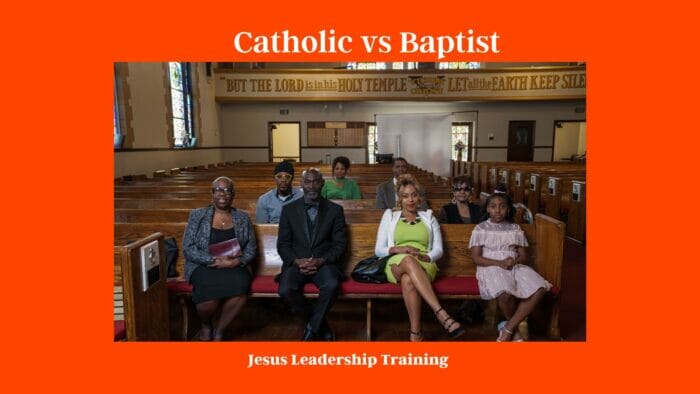
Differences – Long Term
Long-term differences may arise from differing beliefs about sacraments, church authority, and practices. It’s essential to have open, respectful discussions about these differences and find ways to honor both partners’ faith traditions. Mutual respect, understanding, and compromise are critical for such relationships to thrive.
Relationship Challenges
Interfaith relationships may face challenges, including disapproval from family members, differing religious practices, and decisions about children’s religious upbringing. Counseling, both religious and secular, can help couples navigate these issues. Remember, communication is key.
Taking Communion
A key distinction between Catholics and Baptists lies in the sacrament of Communion. Catholics believe in transubstantiation, the transformation of bread and wine into the actual body and blood of Christ. Baptists, on the other hand, view Communion as symbolic. This difference can cause discomfort when one party cannot partake in the other’s Communion service.
Why did Baptists Leave the Catholic Church?
Who Founded the Baptist Church
The Baptist Church emerged from the Protestant Reformation in the 16th century, spearheaded by individuals like John Smyth and Thomas Helwys, who sought a return to the early Christian Church’s simplicity and biblical authority.
here are some major facts and a timeline about the Baptist Church:
Baptist Major Facts
- Origin: The Baptist Church originated in the early 17th century in England and Holland among groups advocating for religious freedom and individual’s direct relationship with God.
- Beliefs: Baptists emphasize believer’s baptism (by full immersion after conversion) and the autonomy of the local congregation. They also strongly uphold the principle of separation of church and state.
- Denominations: There are numerous Baptist denominations worldwide, each with its own distinct set of beliefs and practices, but they generally adhere to the core tenets of the Baptist faith.
- Membership: As of my knowledge cut-off in 2021, the Baptist Church is one of the largest Protestant Christian denominations, with an estimated 35-100 million members globally, varying widely due to the autonomous nature of the denomination.
- Influence: The Baptist Church has been influential in shaping Christian revivalism and evangelicalism and has had a significant impact on American society and politics, especially in the South.
Baptist Timeline
- 1609: The first Baptist congregation was established in Amsterdam by John Smyth, an English Separatist.
- 1638: Roger Williams, a former member of the Massachusetts Bay Colony, established the first Baptist church in America in Rhode Island to ensure religious freedom.
- 1665: The first General Baptists (believing in general atonement) formed in England.
- 1677: The Second London Baptist Confession, expressing the doctrines of Particular Baptists (believing in particular atonement), was published.
- 1845: The Southern Baptist Convention, the largest Baptist and largest Protestant body in the U.S., was formed over differences related to slavery.
- 1895: The National Baptist Convention, the largest predominantly African-American Christian denomination in the United States, was established.
- 1961: The Conservative Baptist Association, a fellowship of evangelical Baptist churches, was formed in the U.S.
- 1995: The Southern Baptist Convention formally apologized for its early stance on slavery and racism.
Please note that the Baptist Church is a decentralized denomination with numerous affiliations and independent congregations, which makes its history multifaceted and complex.
Do Baptists Believe in the Virgin Mary?
Baptists hold Mary in high regard as the mother of Jesus but do not share the Catholic belief in her Immaculate Conception (her being born without original sin) or her Assumption (her bodily ascent to heaven). Baptists see Mary as a model of obedience to God but do not pray to her or view her as a mediator.
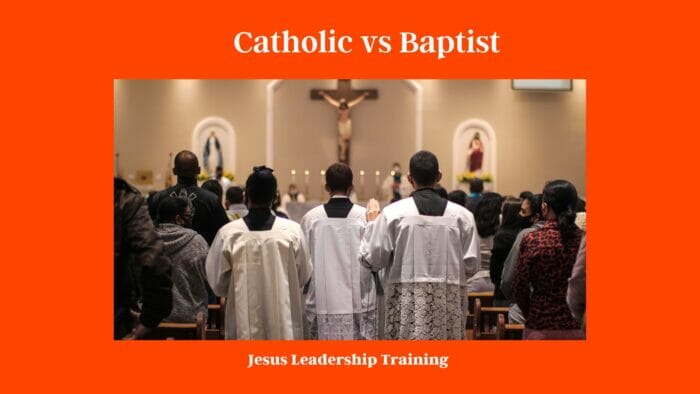
Problems with Baptist Doctrine
The split from the Catholic Church was partly due to disagreements over doctrines such as papal authority, the sacraments, and the role of tradition. Baptists emphasize the Bible as the ultimate authority for faith and practice, rejecting what they see as human additions to God’s Word.
Difference Between Baptist and Christian
While “Baptist” refers to a specific denomination within the Christian faith, “Christian” is a broader term encompassing all who believe in Jesus Christ as their Savior. Therefore, while all Baptists are Christians, not all Christians are Baptists.
Can a Catholic Go to a Baptist Church?
Converting From Catholic to Baptist
While individual stories vary, people convert between Catholicism and Baptist faith for several reasons, including personal conviction, marriage, or a desire for a different worship style or community. Such a decision should be made with careful thought and prayer.
Is It a Sin for a Catholic to Attend Another Church?
According to Catholic teaching, it’s not a sin for a Catholic to visit another church for fellowship or a special event. However, the Catholic Church requires its members to fulfill their Sunday obligation by attending a Catholic Mass.
Why do Catholics and Baptists “Hate” Each Other?
While it’s inaccurate and unfair to claim that Catholics and Baptists hate each other, historical tensions and misunderstandings have sometimes led to unfortunate stereotypes and prejudice. However, many Catholics and Baptists today enjoy friendly relationships, even as they acknowledge their theological differences.
7 Steps to Make Peace
Although “hate” is a strong term, it is true that there can be significant tension between religious groups, including Catholics and Baptists. To encourage reconciliation and foster understanding, consider the following steps:
- Promote Mutual Respect: Encourage both sides to recognize and respect the sincerity of each other’s faith and commitment to living a life aligned with their religious beliefs.
- Encourage Education: Ignorance can often lead to misunderstanding and prejudice. Encourage both Catholics and Baptists to learn about each other’s beliefs, practices, history, and values.
- Focus on Similarities: While there are differences in doctrine and practice, there are also significant shared beliefs, such as belief in Jesus Christ and the Holy Trinity. Emphasize these commonalities to foster a sense of unity.
- Foster Dialogue: Establish forums for open dialogue, where individuals can express their beliefs, concerns, and misunderstandings in a respectful environment.
- Challenge Stereotypes: Confront and challenge stereotypes that both Catholics and Baptists may have about each other. It’s essential to recognize the diversity within each faith community and not to paint all members with the same brush.
- Promote Cooperation: Encourage both Catholics and Baptists to work together on shared concerns, such as charity work, environmental stewardship, and social justice issues. This cooperation can help build mutual respect and understanding.
- Encourage Leadership Engagement: Leaders of both communities have a crucial role in setting the tone for their congregations. Encourage them to promote understanding, respect, and peace from the pulpit and in their community interactions.
Why did Baptists Leave the Catholic Church
Table: Reasons Baptists Left the Catholic Church
| Reason | Description | Impact on Baptist Beliefs |
|---|---|---|
| Sola Scriptura | Baptists believe solely in the Bible as the authoritative source of spiritual truth, differing from the Catholic tradition which also considers the teachings of the Church and the Pope. | Emphasized the authority and sufficiency of the Scriptures alone in matters of faith and practice. |
| Adult Baptism | Baptists emphasize believer’s baptism, which is performed after an individual professes faith in Christ, contrasting with the Catholic practice of infant baptism. | Led to the establishment of believer’s baptism as a symbol of personal faith and commitment to Christ. |
| Autonomy of Local Churches | Baptists value the independence and self-governance of local churches, in contrast to the hierarchical and centralized structure of the Catholic Church. | Encouraged the development of independent, self-governing congregations with congregational polity. |
| Priesthood of All Believers | Baptists believe every Christian has direct access to God and can interpret the Bible individually, differing from Catholicism’s priest-mediated access. | Fostered a sense of individual responsibility in spiritual matters and a personal relationship with God. |
| Salvation by Faith Alone | Baptists hold that faith in Jesus Christ is the sole requirement for salvation, diverging from Catholicism’s emphasis on sacraments and good works in addition to faith. | Reinforced the doctrine of justification by faith alone, underscoring the grace of God in salvation. |
| Separation of Church and State | Baptists advocate for the separation between church and government, in contrast to the historical Catholic alignment with state powers. | Influenced Baptist support for religious liberty, freedom of conscience, and the separation of religious institutions from government interference. |
| Rejection of Sacramental System | Baptists reject the sacramental system of the Catholic Church, viewing baptism and the Lord’s Supper as ordinances and symbolic acts of faith rather than means of grace. | Shaped Baptist worship practices, focusing on the symbolic nature of ordinances and emphasizing personal faith. |
Friendly Summary:
The journey of Baptists diverging from the Catholic Church is like a river branching into different streams, each carving its own path through the landscape. Baptists, with their strong emphasis on the sole authority of the Scriptures, 📖 embraced a path of individual faith expression and the autonomy of local churches.
The vibrant tapestry of Baptist beliefs is woven with threads of adult baptism, symbolizing personal faith in Christ, and the priesthood of all believers, encouraging a direct and personal relationship with God. 🌿
Moreover, Baptists cherish the precious doctrine of salvation by faith alone, highlighting the boundless grace of God. They advocate for the beautiful harmony of church and state separation, fostering an environment of religious liberty and freedom of conscience. 🕊
Lastly, the sacramental tapestry of Baptists is distinctly crafted with symbols of faith, viewing baptism and the Lord’s Supper as reflective ordinances rather than grace-imparting sacraments.
Isn’t it fascinating to explore the diverse spiritual landscapes and the unique pathways each tradition has carved? 🌟
My Boyfriend is Baptist and I am Catholic – Moving Forward
Navigating a relationship where both individuals come from different religious backgrounds can be both challenging and enriching. Here’s a set of steps to guide a couple where one partner is Baptist and the other is Catholic:
Understanding Each Other’s Beliefs
- Open Dialogue: Initiate conversations about your beliefs. Share your faith journey, the rituals you follow, the festivals you celebrate, and the principles you uphold.
- Attend Each Other’s Services: Visit each other’s churches. This will offer firsthand experience of rituals, traditions, and the community.
- Read and Research: Dive into literature that explains the doctrines and histories of both denominations. This will enhance understanding and reduce misconceptions.
Addressing Potential Challenges
- Discuss Core Beliefs: Talk about the fundamental beliefs of both religions, including views on sacraments, salvation, and scripture. Recognize the differences and similarities.
- Seek Counseling: Consider pre-marital or relationship counseling, preferably with counselors familiar with interfaith relationships.
- Discuss Future Plans: If you’re considering a future together, discuss how you’d celebrate religious holidays, where you’d attend church, and how you’d raise children.
Building a Unified Relationship
- Respect Differences: Remember that it’s okay to have different beliefs. The key is mutual respect. Avoid trying to convert one another unless both are open to the idea.
- Find Common Ground: Focus on shared values and beliefs. Both Catholicism and Baptism root themselves in Christian tradition, so there’s much common ground to explore.
- Pray Together: Shared prayer can be a powerful way to connect, even if done in slightly different ways.
- Engage in Interfaith Communities: Join interfaith groups or forums to learn from other couples in similar situations and to seek guidance.
Continued Growth
- Attend Workshops: Participate in workshops or retreats designed for interfaith couples.
- Seek Blessings: If marriage is in the cards, discuss with both religious leaders about the possibility of an interfaith wedding ceremony.
- Stay Updated: As with all relationships, growth and change are inevitable. Continually update each other about any changes in beliefs or practices.
In all these steps, communication, understanding, and love are paramount. Every challenge faced can strengthen the bond if approached with empathy and a willingness to understand. Remember, it’s the shared journey, values, and love for each other that truly defines a relationship, not just religious labels.
10 FAQ’s Catholic vs Baptist
- What are the main differences between Catholicism and Baptism? The key differences lie in the authority of the Pope, with Catholics recognizing his authority while Baptists do not, the view of sacraments, where Catholics have seven and Baptists only two, and the baptism practice where Baptists insist on believer’s baptism instead of infant baptism practiced by Catholics.
- Do Catholics and Baptists believe in the same God? Yes, both Catholics and Baptists believe in the same God. They both affirm the Trinity doctrine, acknowledging God as Father, Son, and Holy Spirit.
- Why did Baptists separate from the Catholic Church? Baptists emerged from the Protestant Reformation, a movement that sought to reform what it viewed as corruption and doctrinal inaccuracies within the Catholic Church. They particularly disagreed with the hierarchical structure of the Church and the practice of infant baptism.
- Can a Catholic attend a Baptist church? Yes, a Catholic can attend a Baptist church. While there may be differing doctrines and practices, both belong to the broader Christian faith, and it’s not considered a sin for Catholics to attend other denominations’ services.
- Do Baptists recognize the authority of the Pope? No, Baptists do not recognize the authority of the Pope. They uphold the principle of the ‘priesthood of all believers’, meaning each individual can have a direct relationship with God without the need for a mediating figure.
- Can a Baptist marry a Catholic? Yes, a Baptist can marry a Catholic. Inter-denominational marriages are common. However, they may face challenges in reconciling differing beliefs and practices, and decisions about how children will be raised in terms of religious practice will need to be made.
- Do Baptists believe in the Virgin Mary? Baptists honor Mary as the mother of Jesus but do not ascribe the same level of veneration to her as Catholics do, such as doctrines of Immaculate Conception and Assumption.
- What are the main Baptist denominations? Major Baptist denominations include Southern Baptist Convention, American Baptist Churches USA, National Baptist Convention, and Independent Baptist Churches.
- What’s the difference in worship style between Catholics and Baptists? Catholic worship is more liturgical and structured, centered around the Mass and Eucharist. Baptist worship is often less formal with a significant emphasis on the sermon and Bible study.
- How does Baptists’ interpretation of the Bible differ from Catholics’? While both Baptists and Catholics see the Bible as the inspired word of God, Baptists typically adopt a more literal interpretation and believe in ‘sola scriptura’ – the Bible as the ultimate authority in matters of faith and practice. Catholics, on the other hand, combine scripture with Church tradition and Papal authority for their theological foundation.
Final Thoughts
In conclusion, while Catholics and Baptists have distinctive beliefs and practices, they share a common faith in Jesus Christ as Savior. Understanding these differences, along with an attitude of respect and love, can lead to fruitful dialogue and cooperation between these two Christian traditions.
It’s crucial to remember that faith is personal, and individual beliefs can vary widely within a religious tradition. Therefore, blanket statements or generalizations about either group should be avoided. Instead, let’s foster an environment of dialogue, mutual respect, and understanding.




